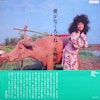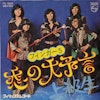Shintaro Sakamoto’s debut solo album “sounds like a bunch of dead people, who for some reason haven’t figured out they’re dead yet, having a good time playing music,” so says a close, unnamed friend of the former Yura Yura Teikoku front man.(1) Before disbanding the trio in 2009, Sakamoto and his bandmates were the biggest and oldest “underground” psych/pop/rock band in Japan, selling out arenas domestically and even touring the U.S. a couple times, once following DFA Records’ release of their last album, Hollow Me. Listening backwards into the YYT discography, Sakamoto’s influence within the band becomes obvious: his knack for a pop hook, subtle nods to vintage sounds, and dynamic yet sparse arrangements—making songs that sound simultaneously worn and otherworldly. Working in isolation on 2013’s How to Live with a Phantom, Sakamoto called all the shots musically and lyrically, and he continued to mine a familiar YYT theme: “Death has always been the concept for me when working on a song,” Sakamoto said in a recent interview. “In my latest album, I tried to capture ‘death’ and ‘life’ in the most unsentimental and flat way as possible.”(2)
Music about death has never felt so carefree. Contributing all the keys, guitars, bass, and lead vocals, Sakamoto recorded his album as a band of one in the style of Rundgren, Wonder, or McCartney (particularly in Sakamoto’s buoyant and joyful bass notes, though he credits Funk Brother James Jamerson as his prime influence). The mood is light, poppy, yet melancholic with shimmering guitars, bubbling bass, and tasteful percussion accents resulting in a mysterious final product that’s just out of reach, whether you understand Japanese or not. The United Nations basement bar in Bangkok circa 1975, the intergalactic cantina from Star Wars on a slow weeknight, or Purgatory’s VIP Lounge are all fitting settings for Sakamoto’s timeless yet fantastical tunes where “the audience—normally shy people who rarely let their hair down—start to feel more relaxed and, before they know it, starts to dance.”(3)
How to Live with a Phantom deals “with the idea of how we reconcile or come to terms with a general feeling of despair as we try to put together happy lives for ourselves.”(4) Like Haruki Murakami, whose 1997 novel The Wind-Up Bird Chronicle addresses similar themes, Sakamoto is not the only Japanese artist obsessed with death. “I get the feeling that there are a lot of Japanese today, myself included,” Sakamoto writes via email, “who don’t expect much of the future in Japan.” Is Japan or Tokyo the phantom that Sakamoto is serenading? “Living in this town / Watching people come and go / And trying to keep your cool when you should be excited,” Sakamoto sings of his coping method for how to live in a country that’s lost its compass on the standout track “You Just Decided.” Under proper conditions, desperate countries create desperate artists like Sakamoto, who push ahead. “Even though I have no expectations,” he adds. “At the same time, I don’t think there’s anything wrong with making something.”
Desperation and frustration can inspire and motivate artists, pushing them to find hope, love, or meaning through their creations. Sakamoto’s album brilliantly blends pop, lounge, ’70s rock, and R&B styles into an unlikely expression of national or cultural therapy. Other Music has released the follow-up single (recorded during the same sessions as Phantom), “Don’t Know What’s Normal” b/w “From the Dead,” another couple nuggets of pop perfection providing a gleam of hope: “I’m so happy I met you here / Playing guitar in total darkness / A sad melody / A gleam of hope / It’s hard to find / I’m looking for it.”





